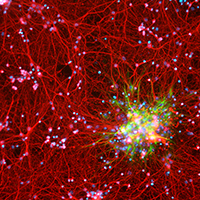Quantitative, structural and molecular changes in neuroglia of aging mammals: A review

Accepted: 27 May 2021
HTML: 11
All claims expressed in this article are solely those of the authors and do not necessarily represent those of their affiliated organizations, or those of the publisher, the editors and the reviewers. Any product that may be evaluated in this article or claim that may be made by its manufacturer is not guaranteed or endorsed by the publisher.
Authors
The neuroglia of the central and peripheral nervous systems undergo numerous changes during normal aging. Astrocytes become hypertrophic and accumulate intermediate filaments. Oligodendrocytes and Schwann cells undergo alterations that are often accompanied by degenerative changes to the myelin sheath. In microglia, proliferation in response to injury, motility of cell processes, ability to migrate to sites of neural injury, and phagocytic and autophagic capabilities are reduced. In sensory ganglia, the number and extent of gaps between perineuronal satellite cells – that leave the surfaces of sensory ganglion neurons directly exposed to basal lamina– increase significantly. The molecular profiles of neuroglia also change in old age, which, in view of the interactions between neurons and neuroglia, have negative consequences for important physiological processes in the nervous system. Since neuroglia actively participate in numerous nervous system processes, it is likely that not only neurons but also neuroglia will prove to be useful targets for interventions to prevent, reverse or slow the behavioral changes and cognitive decline that often accompany senescence.
How to Cite
PAGEPress has chosen to apply the Creative Commons Attribution NonCommercial 4.0 International License (CC BY-NC 4.0) to all manuscripts to be published.
Similar Articles
- Carlo Alberto Redi, Immunoelectron microscopy - Methods and protocols , European Journal of Histochemistry: Vol. 55 No. 3 (2011)
- F Leone, A Bairati, L Vitellaro-Zuccarello, The cytoskeleton of chondrocytes of Sepia officinalis (Mollusca, Cephalopoda): an immunocytochemical study , European Journal of Histochemistry: Vol. 48 No. 2 (2004)
- T Cremer, C Cremer, Rise, fall and resurrection of chromosome territories: a historical perspective. Part I. The rise of chromosome territories , European Journal of Histochemistry: Vol. 50 No. 3 (2006)
- S Modina, V Borromeo, AM Luciano, V Lodde, F Franciosi, C Secchi, Relationship between growth hormone concentrations in bovine oocytes and follicular fluid and oocyte developmental competence , European Journal of Histochemistry: Vol. 51 No. 3 (2007)
- G Palmieri, F Acone, S Desantis, A Corriero, G Ventriglia, P Addis, S Genovese, A Aprea, D Spedicato, M Losurdo, M Deflorio, A Di Summa, G De Metrio, Brain morphology and immunohistochemical localization of the gonadotropin-releasing hormone in the bluefin tuna, Thunnus thynnus , European Journal of Histochemistry: Vol. 52 No. 1 (2008)
- S Nemolato, S Serra, S Saccani, G Faa, Deparaffination time: a crucial point in histochemical detection of tissue copper , European Journal of Histochemistry: Vol. 52 No. 3 (2008)
- A. Arcucci, M.R. Ruocco, F. Albano, G. Granato, V. Romano, G. Corso, C. Bancone, E. De Vendittis, A. Della Corte, S. Montagnani, Erratum - Analysis of extracellular superoxide dismutase and Akt in ascending aortic aneurysm with tricuspid or bicuspid aortic valve , European Journal of Histochemistry: Vol. 59 No. 1 (2015)
- Flavia Carton, Laura Calderan, Manuela Malatesta, Incubation under fluid dynamic conditions markedly improves the structural preservation in vitro of explanted skeletal muscles , European Journal of Histochemistry: Vol. 61 No. 4 (2017)
- F Cappello, C Tripodo, F Farina, V Franco, G Zummo, HSP10 selective preference for myeloid and megakaryocytic precursors in normal human bone marrow , European Journal of Histochemistry: Vol. 48 No. 3 (2004)
- A Alunni, S Vaccari, S Torcia, Characterization of glial fibrillary acidic protein and astroglial architecture in the brain of a continuously growing fish, the rainbow trout , European Journal of Histochemistry: Vol. 49 No. 2 (2005)
<< < 73 74 75 76 77 78 79 80 81 82 > >>
You may also start an advanced similarity search for this article.

 https://doi.org/10.4081/ejh.2021.3249
https://doi.org/10.4081/ejh.2021.3249










